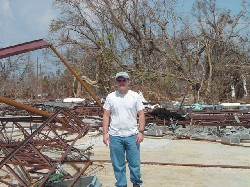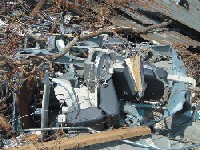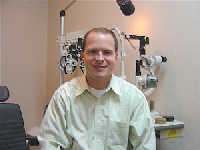Midnight, Saturday, August 27, New Orleans optometrist David Baptiste was awake, waiting to watch his favorite TV show. But news broadcasts broke in. Hurricane Katrina was coming. And coming strong.
Dr. Baptiste lived in New Orleans all his life and never evacuated. But when he saw the size of the storm on TVit seemed to cover the entire Gulf of Mexicohe and his wife immediately went to his East New Orleans office in the wee hours of Sunday morning to start packing.
8 a.m. Sunday. Optometrist David Heitmeier was with friends from the West Jefferson Levee District, the organization responsible for maintaining the levees. They showed Dr. Heitmeier computer models that indicated Katrina would be a Category 5 storm, with winds greater than 155 miles per hour and storm surges higher than 18 feet. Katrina was headed straight for the city.
Dr. Heitmeier never evacuated before either. But when the levee board decides its time to evacuate, you better take their advice, he says. By Sunday night, Dr. Heitmeier was 100 miles north of the city, staying in the house of a fellow optometrist.
6 a.m. Monday. Dr. Baptiste was in the car with his family for 18 hours in a slow bumper-to-bumper exodus toward Houston. Also with them: Dr. Baptistes newly hired doctor, Tenesha Bazemore, O.D. If she can make it through that [car ride], she can make it through anything, Dr. Baptiste says.
They checked into a hotel, only to find that a broken water pipe had soaked the carpet in their room. I ran from water to get water, he says.
7 a.m. Monday. Katrina made its first landfall at the bottom tip of Louisiana, about 100 miles south of New Orleans, averting a direct impact on the city. The storm had been downgraded to a Category 4.
We thought we got lucky, that we had dodged another one, says Dr. Heitmeier, who kept in touch with his friends at the levee organization. Then the levee broke.
12 noon, Monday. Water breached the levee at the 17th Street canal.
About five miles away, optometrist Albert C. Burns was in his office. After the storm passed, everything was fine, though water filled the streets, Dr. Burns says. Were used to that, so I waited for the water to go down. But it didnt go down, it kept coming up.
Where he was, the water rose gradually. But at his home, just blocks from the broken levee, Dr. Burns wife and mother-in-law fled to the attic to escape the rapidly rising water. Within 20 minutes, water had filled the house. Mrs. Burns and her mother spent the night in the attic, waiting for help to arrive. Dr. Burns, trapped by the water, spent the night in his clinic.
Tuesday morning. News on the radio confirmed Dr. Burns suspicion: the levee had indeed broken. Anybody who lives in New Orleans could figure out that once the levee broke, things werent going to get better. Things were only going to get worse, he says.
Dr. Burns waded from his office, walking and swimming his way to the Superdome, the only evacuation point he could reach. Meanwhile, back at his home, his wife shouted from the attic window to two men in a kayak paddling by. The men untied a boat that Dr. Burns kept in the backyard, and helped Mrs. Burns and her mother onboard. They made their way along Canal Street until they encountered another boat, and eventually were taken to a shelter at an old high school in Metarie, La.
At the Superdome, Dr. Burns faced inhuman conditions. There was gunfire, stories of rape and murder, and the place just went septic very quickly, he says. A lot of the time I spent at the Superdome was outside because it got to be uninhabitable inside.
Dr. Burns declined to give details or describe how he spent his time waiting for help to arrive, an anonymous person in a crowd of seething and forsaken humanity. It was like being in jail, but worse than jail because at least in jail you have some identity, he says.
Tuesday night. Dr. Heitmeier got a phone call from the chief of the levee board. He told Dr. Heitmeier they were working around the clock, in the sludge, to rebuild the levee. Amid this, the chief acquired a nasty bacterial infection in his eye. Could Dr. Heitmeier come back into the city under the authority of the levee board?
Wednesday. Dr. Heitmeier came back into New Orleans, went to his rain-soaked office on the West Bank to retrieve whatever supplies he could, and treated the chiefs eye. As word of his services got out, Dr. Heitmeier was soon responding to calls from police departments and others who needed help. He distributed eyewash, contact lens solutions, contact lens samples, antibiotics and more. He gave away about 50 old pairs of wraparound cataract sunglasses he had in his office.
When Dr. Heitmeier ran out of antibiotics, a team of law enforcement officials got together, broke into a drug store and procured some more.
Thursday, Friday. Buses finally arrived at the Superdome, but 36 hours went by before Dr. Burns could get on board. When he arrived at a shelter in Texas, he called a nearby cousin who came and picked him up. On Saturday, Dr. Burns managed to get a hold of his wife by e-mail, and she joined him in Texas.
The hurricane flooded New Orleans, but when Katrina finally made landfall on the border of Louisiana and Mississippi at about 11 a.m. Monday, it flattened everything in its path.
Optometrist James Benignos office was 850 feet from the Gulf of Mexico, in a shopping strip in Pass Christian, Miss. His office was on the same spot where an apartment building used to stand. Legend has it that residents of the apartment building were having a hurricane party when Hurricane Camille demolished the building in 1969.
Like the apartment building, Dr. Benignos office was destroyed. All that is left is the concrete slab.
We thought wed never get another Hurricane Camille, and we didnt, he says. This was worse.
 |
| Nothing left but the slab: James Benigno, O.D., stands on the concrete foundation where his office used to be, in Pass Christian, Miss. |
 |
| Dr. Benignos exam chair is nearly hidden in the rubble. |
 |
| Dr. Benigno (and the chair) in happier times. |
He hopes to start up a new office further away from the Gulf.
Meanwhile, Dr. Baptiste, along with his new hire, Dr. Bazemore, have settled in Fort Worth, Texas, with temporary licenses and plans to stay.
Dr. Burns, trying to put his Superdome experience behind him, continues to face bureaucratic and governmental red tape to get his life back in order. He has taken a part-time position at a Wal-Mart in Winnsboro, La., and hes trying to make the best of a difficult situation. He and his wife hope to move out of the motel where theyve been staying and into a home.
Dr. Heitmeier, whose office suffered comparatively minimal damage, will continue to live and work in New Orleans. He hopes to have his office up and running in the not-too-distant future.
Going through such an experience, you realize that the things that are really important are your family, your friends and your faith, Dr. Heitmeier says. It makes you take a step back and realize the important things in this journey we call life.

